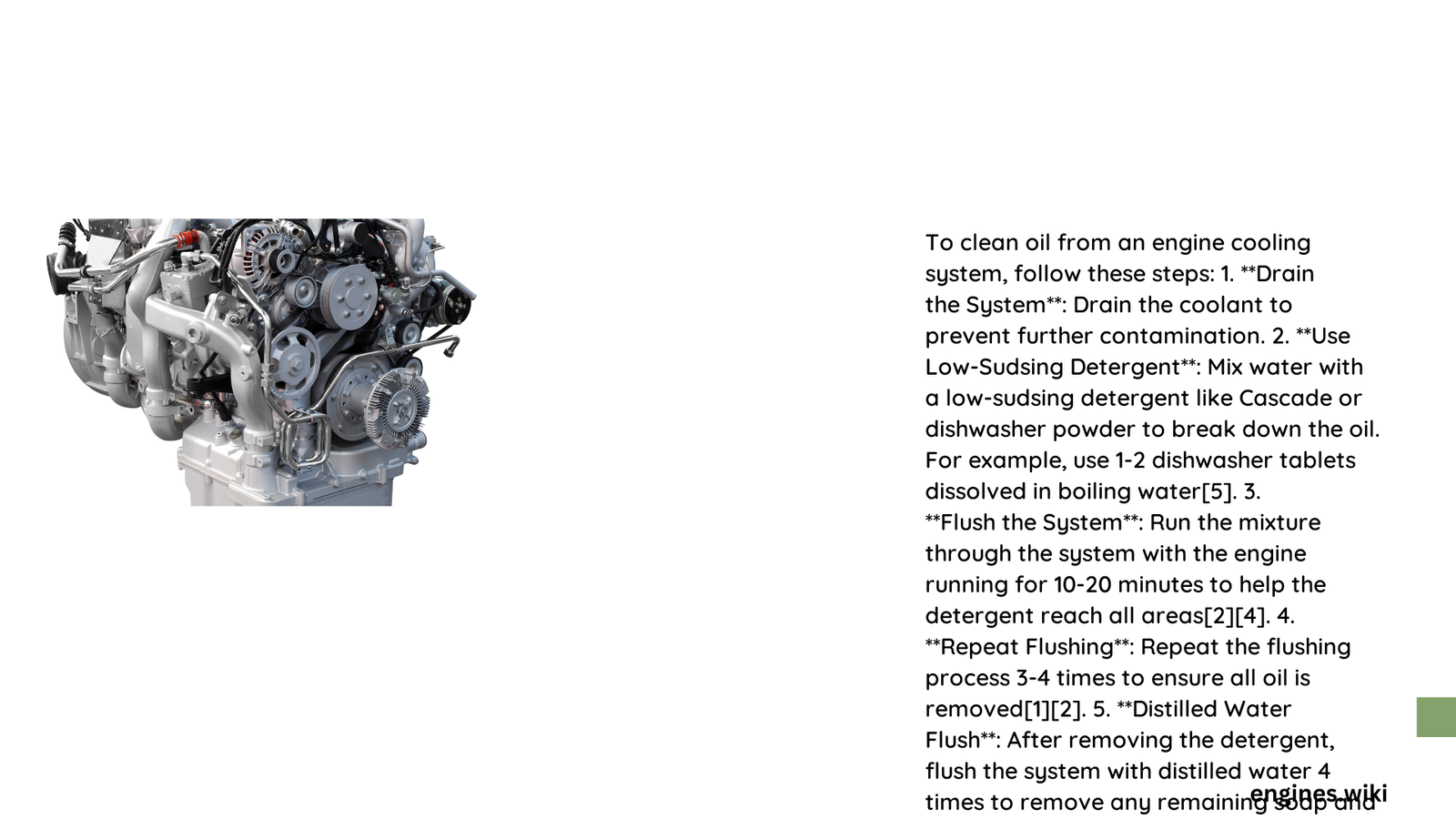Cleaning Oil from Engine Cooling System: Expert Removal Techniques
Quick Overview
Oil contamination in an engine cooling system can severely compromise vehicle performance, leading to potential overheating, reduced heat transfer efficiency, and long-term mechanical damage. Vehicle owners and mechanics must understand precise cleaning techniques that safely remove oil residues without causing additional system complications.
Why Does Oil Contaminate Cooling Systems?
Common Causes of Oil Intrusion
- Head Gasket Failure: Creates pathways for oil to mix with coolant
- Cracked Engine Block: Allows internal oil leakage
- Damaged Transmission Cooler: Permits oil cross-contamination
- Worn Seals: Enables gradual oil migration
What Cleaning Agents Work Best?
| Brand | Active Ingredients | Effectiveness | Price Range |
|---|---|---|---|
| BG Universal Cleaner | Sodium-based compounds | High | $20-$30 |
| Prestone Super Radiator Cleaner | Sodium citrate | Medium-High | $10-$25 |
| DEI Radiator Relief | Multi-purpose cleaning agents | High | $15-$30 |
How to Diagnose Oil Contamination?
Visual Inspection Techniques
- Check coolant color and consistency
- Look for milky or brownish liquid
- Inspect for oily film on radiator surfaces
- Monitor coolant level fluctuations
Step-by-Step Cleaning Process
Preparation Requirements
- Tools Needed:
- Radiator petcock wrench
- Drain pan
- Funnel
- Distilled water
- Recommended cleaning agent
- Protective gloves
- Safety glasses
Detailed Cleaning Procedure
- Coolant Drainage
- Ensure engine is completely cool
- Open radiator petcock
-
Drain existing coolant into appropriate container
-
Cleaning Agent Application
- Select appropriate cleaning solution
- Add recommended quantity to cooling system
-
Fill remaining space with water
-
Engine Operation
- Run engine at normal operating temperature
- Maintain recommended duration (10-30 minutes)
-
Monitor temperature gauges
-
Flushing Process
- Drain cleaning solution completely
- Flush with distilled water
- Repeat until water runs clear
Prevention Strategies
Long-Term Maintenance Tips
- Regular cooling system inspections
- Annual coolant replacement
- Address minor leaks immediately
- Use high-quality coolant
- Monitor engine performance indicators
Potential Risks of Neglecting Oil Contamination
Consequences
- Reduced heat transfer efficiency
- Potential engine overheating
- Accelerated component wear
- Increased repair costs
- Potential complete engine failure
Cost Considerations
Estimated Expenses
- DIY Cleaning: $50-$100
- Professional Service: $200-$500
- Potential Engine Repair: $1,500-$4,000
Expert Recommendations
- Always use manufacturer-recommended cleaning agents
- Follow precise instructions
- Wear appropriate safety equipment
- Consider professional assistance for complex issues
Warning Signs Requiring Immediate Attention
- Persistent coolant contamination
- Unexplained coolant loss
- Consistent overheating
- Unusual engine performance
Technical Insights
Chemical Interaction
Oil contamination creates complex chemical interactions within cooling systems, potentially forming emulsions that reduce heat transfer capabilities and promote corrosive environments.
Final Thoughts
Effective cleaning of oil from engine cooling systems requires systematic approach, appropriate tools, and careful execution. Regular maintenance and prompt addressing of contamination sources can significantly extend engine life and performance.
References:
- https://www.bgprod.com/catalog/cooling-system/bg-universal-cooling-system-cleaner/
- https://bobistheoilguy.com/forums/threads/cooling-system-cleaners-which-work-best.48733/
- https://www.onallcylinders.com/2024/02/21/how-to-clean-your-cooling-system-with-an-easy-chemical-flush/

